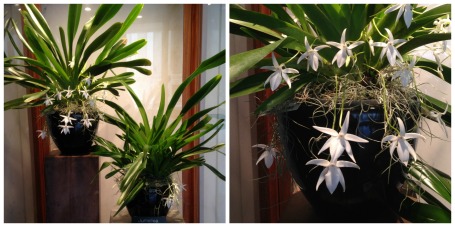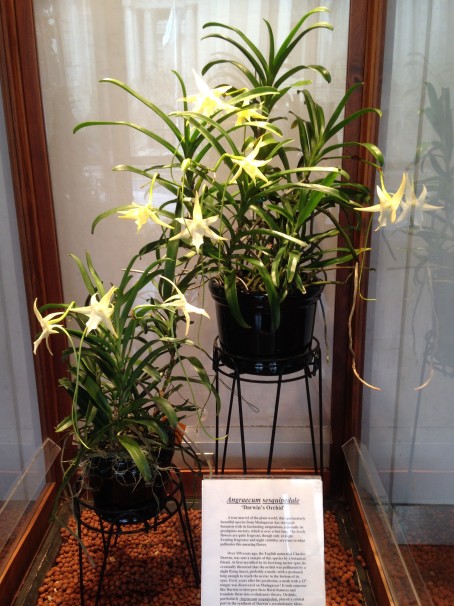Posts tagged ‘orchid’
A Tropical State of Mind: What’s Blooming in the Smithsonian Gardens Orchid Collection
It’s March and it definitely feels like spring. This week’s blooming orchid selections are inspired by the tropical weather we’ve been having the past few days. Our species greenhouse has been looking rather tropical as well…

First on our list this week is Bulbophyllum saurocephalum, which is an epiphytic Philippine species. This odorless plant is also known as the Lizard Head Bulbophyllum because of the numerous tiny flowers that seem to be rearing their striped heads from the surface of the rachis.
Another drastically different Bulbophyllum that is blooming not far from B. saurocephalum is Bulbophyllum compressum. This is a hot growing Indonesian species found at lower elevations, with beautiful, ovate floral bracts of up to 30 delicate,white flowers.

Bulbophyllum compressum
I tend to gravitate towards the strangeness of Bulbophyllums, but I recognize that there are many other genera that are equally fascinating and worthy of mention. Below is the tiny flowered Tolumnia bahamensis.

Tolumnia bahamensis
Not only is this a fascinating North American species, it is highly appropriate to our tropical theme for this week. This species starts its life as a terrestrial in sandy soil, and as it matures, will send out growths that attach to taller plants, transitioning to an epiphytic habit. Tolumnia bahamensis is only found in Atlantic coastal scrub habitats and is considered highly endangered. Atlanta Botanical Garden has been leading reintroduction efforts in Florida with much success.
To see part of the Smithsonian Gardens Orchid Collection on display, visit the Orchids In Focus exhibit at the United States Botanic Garden through April 27!
–Julie Rotramel, Living Collections Specialist, Smithsonian Gardens
March 11, 2016 at 10:00 am smithsoniangardens Leave a comment
On Display: Highlights from the Smithsonian Gardens Orchid Collection
In keeping with my greatest goal in life of turning everyone into an orchid lover (I believe we would achieve world peace if that actually happened), I am starting a series of blog posts about the Smithsonian Gardens Orchid Collection. I’m excited to share images and stories about our incredible orchid collection with you.
Last week, I convinced Alex, one of Smithsonian Gardens’ interiorscapers, to exhibit some really special orchids in display cases at the Smithsonian’s National Museum of American History. If you are in Washington, D.C., I hope you’ll visit the cases on the first level of the museum near the Warner Bros. Theater before the display is changed the week of December 21st. If you’re too far away, I hope you’ll enjoy the images of these beauties orchids included here.
Angraecum sesquipedale may very well be the most famous of all orchids. This beauty is written up in every botany textbook due to its compelling pollination story. A native of Madagascar, this outstanding species bears truly lovely, white, star-shaped blooms that emit a delicious fragrance to attract its moth pollinator on moonlit nights. Not just any moth, but the equally famous Xanthopan morganii praedicta, so named because its existence was predicted by Charles Darwin before it was known to science. Darwin theorized upon seeing the flowers’ prodigious 12-inch long nectar spurs that a moth with an equally long proboscis had to exist in order for the plant to be pollinated. It will always be one of my favorite orchids because, well, it’s just plain cool! The variety on display, Angraecum sesquipedale var. angustifolium, is a bit more succulent and smaller in stature than the typical form, but it is easier to grow and quite floriferous.

L to R: Angraecum sesquipedale var. angustifolium from the Smithsonian Gardens Orchid Collection; Illustration of a hawk moth visiting an Angraecum sesquipedale by Emily Damstra for the Smithsonian Institution; a Xanthopan morganii praedicta (hawk moth) with extended proboscis © kqedquest
A couple of well-bloomed plants from a sister genus, Jumellea, grace the display case opposite the Angraecums. Even though their flowers are smaller, they are plentiful and have an outstanding fragrance. Jumellea flowers are similar in all of their species, even though the plants can vary wildly. They, like the Angraecums, exhibit a moth pollination syndrome, bearing flowers of the purest white color with strong nocturnal fragrance and nectar spurs. This time the spurs are much shorter, about an inch or so in length, indicating a very different moth species as its pollination partner. Jumelleas are also used to make a kind of aromatic tea, known as Faham tea, which was once very popular in Europe.

Jumelleas from the Smithsonian Gardens Orchid Collection on display at the National Museum of American History
These are remarkable orchids that Smithsonian Gardens proudly displays to encourage and educate Smithsonian visitors. We hope you will visit the National Museum of American History and see these botanical marvels for yourself!
– Tom Mirenda, Smithsonian Gardens Orchid Collection Specialist
Rare and Beautiful Orchids (and a Horticulturist) Find Home at Smithsonian Gardens
Imagine opening an innocuous cardboard box and finding this inside!
I was fortunate to have this pleasure on one of my first days on the job as a horticulturist with Smithsonian Gardens. Already amazed (and slightly overwhelmed) by the diversity of orchids in the Smithsonian Gardens Orchid Collection, my first week on the job included helping my colleagues unpack a tractor trailer full of boxes containing a major donation of orchids.

Anne, a Smithsonian Gardens volunteer, assists Emily and the other greenhouse staff unpack boxes of donated orchids.
Hundreds of specimens were added to the orchid collection at the Smithsonian Gardens Greenhouse Facility in Suitland, MD. The plants were part of an extensive collection owned by the late Denis Roessiger of Penobscot, ME, that have been generously donated by his wife, Lucybelle.
Horticulturists from the Smithsonian Gardens greenhouses journeyed to Maine to select and carefully pack up the orchids, which then travelled overnight by truck to the Suitland greenhouse facility. There, greenhouse staff and volunteers eagerly unloaded and unpacked the vast array of plants. “This donation is exceptional in that 99% of the orchids are species orchids or rare hybrids,” commented Smithsonian Gardens Orchid Specialist, Tom Mirenda. The donation is a major addition to the Smithsonian Gardens’ collection, adding entirely new genera to it and increasing the species abundance and overall diversity.
I asked Tom Mirenda to give me a walk-through of the highlights of the donation. Here are his top picks:

(L to R) Bulbophyllum amplebracteatum subsp. carunculatum ‘Sunset Valley Orchids’ and Bulbophyllum cocoinum
Over 200 new Bulbophyllum specimens now complement the already extensive collection of this genus maintained by Smithsonian Gardens. Bulbophyllum is one of the largest and most ancient genus of orchids; found in tropical forests around the world, they are often odd-looking plants with peculiar, sometimes foul, fragrances. “One of my favorites currently in bloom is Bulbophyllum cocoinum, which has a coconut fragrance,” says Mirenda. The donation also included fifteen species of Trichoceros, a new genus for the collection. Trichoceros are epiphytic and terrestrial orchids native to the Andean Mountain range in South America.
The donation tripled Smithsonian Gardens’ collection of hard to find Maxillaria orchids, and added 50 to 70 species of Restrepia and several large specimen Coelogyne and Dendrochilum. Also new to the collection are several Lycaste and Dracula species. Rare color forms of Laelia and Cattleya now grace the collection. Orchid enthusiasts will swoon at the large addition of South American Slipper Orchids (Phragmipedium), particularly the controversial Phragmipedium kovachii—the orchid at the heart of the book, Scent of a Scandal.
Large, brilliant, purple flowers of an eight-foot Vanda were one of the showiest surprises during unpacking. One of the Smithsonian greenhouses has been transformed with the addition of roughly 40 Vandas now hanging from the ceiling and suspended racks.
With the acquisition of these plants, our orchid collection now has well over 10,000 specimens. “By continually building our collection in this way, we have made the Smithsonian Gardens Orchid Collection a true scientific resource,” says Mirenda.
– Emily Cook, Horticulturist, Smithsonian Gardens
A Spectacular Show: What’s Blooming in the Smithsonian Gardens Orchid Collection
The sight of fresh blooming encyclias is one to tease the eyes. Generally small flowered and often less than an inch in diameter, encyclias pack a punch with their unending shape and color variations. Orchid lovers could spend days observing these species and hybrids. This hardly comes as a surprise when you take into consideration that there are over 150 species in the genus.

Encyclia Nursery Rhyme
Originating from the Greek word, enkylein, the name encyclia refers to the way the lateral lobes of the flower encircle the column. Found from central Florida to Brazil, these orchids grow in warmer climates and produce psuedobulbs in clumps. Each clump sends up several flower spikes at a time and each variety of encyclia has flower spikes that range in a length from a foot to several feet long. Since each spike can produce many flowers these spikes make for quite a spectacular show.

A clustering of Encyclia oncidioides behind Encyclia Cindy.
I find these orchids very pleasing to observe. Their small flowers make them manageable to view, but contain subtle details that are a delight to discover. These flowers have great depth to them, so changing your angle of view can reveal more interesting characteristics.
Encyclias are often crossed with the genera Cattleya and Epidendrum to create lovely hybrids. Encyclias are desirable for their interesting flower shapes and Encyclia cordigera in particular often is selected for hybridization for its darker colors and intoxicating aroma. Encyclia cordigera has received over 40 awards from the American Orchid Society, so why not pass along some of these winning characteristics to other orchids?

Encyclia Atroniceum x bractescens

Encyclia alata x mooreana
In the Smithsonian Gardens Orchid Collection, there are currently over 60 examples of these encyclia species and hybrid combinations. Their flowers last up to a month sometimes longer, so they regularly make their way to the display cases in museums around the Smithsonian. Be sure to swing by the orchid cases downstairs in the National Museum of American History sometime in the next few weeks to see one of these incredible orchids on display.
– Alan Marcus, Smithsonian Gardens Orchid Intern

Encyclia Cindy







